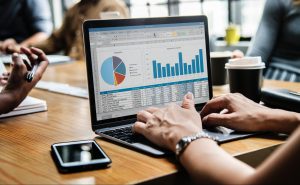Digital signage is a cost effective solution to address your audience, as you know. It also allows you to experiment and learn which content reaches your target audience best. Digital signage furthermore is able to help you learn the location of your target audience. It does this, and more, through the power of analytics.
This word might put an image of high-tech analytical tools, artificial intelligence, and extremely expensive technology in your head. But this is really not the case with digital signage analytics. You can track data even now, without any additional tool. All you need is a digital display, and that’s it! Of course, there are more advanced methods for tracking and analyzing data, but they’re really not as intimidating as one might think. All you need is to get yourself organized. Let’s take a closer look, starting from scratch.
A vital factor in content creation
Analytics are tremendously useful not only when creating the content itself, but also when it comes to its location. Tracking the change of your profit and traffic from the moment your new campaign goes up can tell you much. Clearly, it can tell you whether or not an ad is effective in reaching out to people, but combining that data with the data of other campaigns can show you which content is most effective, as well as which location has the most people interested in your offer.
This is certainly the simplest way of collecting analytics, and any business can do it, just by being organized and without fancy sensors or interactive digital signage, which we’ll take a closer look at now.
Interactivity opens more doors
Interactivity used to be a high-tech feature of digital signage, but that isn’t the case anymore. It’s a natural progression of digital signage, and these days if a display is within arm’s reach, there really isn’t a reason why it shouldn’t be interactive!
Digital displays with interactive capabilities allow you to track your customer’s behavior. If you showcase products, you can track which products get the most attention, products which nobody cares about and, of course, which products they purchase the most, for example. Interactivity can provide all sorts of data. Let’s say you see that many users take a closer look at a certain product but don’t actually buy it. This may imply there is something turning them away. In this scenario, a minor adjustment in price or a special offer might entice them to buy.
And, of course, customers can provide feedback more easily, or even rate products, if the interactivity feature is activated.
Using Wi-Fi for analytical data
Wi-Fi tracking works through the anonymous analysis of customer behavior. It shows which paths customers take and what they look at. However, mobile tracking-based solutions lack precision mainly due to legal and privacy restrictions. Because of this, it’s unwise to rely solely on this method of tracking. Instead, it should be used as a minor additional source alongside other measures of analytics.
Feedback can be tied in with this topic. If you include a feedback option in your in-store displays customers can provide it to you. Direct feedback from the consumer is always the most powerful data you can have. The same feature can weaved into your Wi-Fi provision. Brainstorming a bit can bring you to the best ways to implement this. For instance, you could ask a single question each time users sign in to your Wi-Fi network.
Enhance analytics with automation
AI combined with digital signage takes you to a new reality of data tracking as it measures data very accurately and uses it immediately. For a start, once the sensors measure how many people stand in front of the digital display you have set up, content can be displayed automatically. Sensors can analyze their faces to establish which demographic people observing the display belong to. This information can tell you which persona to target in your upcoming campaigns.
With relevant data collected on the demographic, AI has the benefit of displaying content automatically based on the people in front of the display. Still, if you’re interested in this topic, make sure to research more on the legal and social standing of the country or state you’re in. This is mainly because there are many who aren’t big fans of their faces being read by a machine.
Which data to track?
Chances are, you already keep track of a lot of data and thus many sources are available to you already. Now, you simply need to correlate them with each other. We’ve mentioned some of the most important (and most obvious) data to track. A higher profit, for instance, is a clear indicator that something is working, showing you which location and content type works best. A change in traffic is another, as well as a raise or drop in interest or purchases of a specific item.
In more specific cases, for any store, the most important metric is footfall which indicates how many shoppers walking by the entrance actually enter the store. This tells you how effective your window advertising is in drawing people in. After that, you want to know how many of those shoppers who entered actually made a purchase. This data can tell you if you’re drawing in the right people. If you see that many people who enter don’t actually buy, you can choose to either adapt your products/business, or your campaign targeting.
Analytical data can come from different sources and used for different purposes. If used correctly, this offers incredible insights. Having quality digital signage analytics can be extraordinarily effective at enhancing the customer experience. For instance, airports using sensors can detect real-time passenger flow, letting them know how many check-in points they need to open to eliminate a bottleneck. This is of course a topic for a large scale operation which has the required means at its disposal.
“Do I really need analytics?”
To choose not to use digital signage analytics, and to think of it as a component without which a business can reach a peak is a mistake. Figuratively speaking, it would mean blinding yourself to the path which leads to success. Any success you’ve achieved in business so far has been through analytics, after all.
Think about it!
When you start a new business, you first research whether or not there is a need for it. And if you’re convinced that people would want to buy it, you begin! This is analytical data. Basic and very vague, but simply knowing there is a need for a product you provide indeed is analytical data. Digital signage can’t work in your favor without it. It doesn’t need to be AI or facial recognition technology, but it has to be present to some degree. The greater degree, the clearer the image of the aforementioned path to success.









